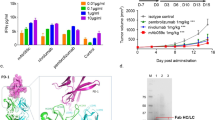Abstract
Apoptosis, or programmed cell death, is an essential process affecting homeostasis of cell growth, development, and the elimination of damaged or dangerous cells. Inappropriate cell death caused by oxidative stress has been implicated in the development of neurodegenerative diseases such as Alzheimer’s, Parkinson’s, and stroke. On the other hand, a defect in the cell death process leads to the development of cancer. For example, the main player of apoptosis, p53, is defective in many of the human cancers. Apoptosis is regulated by the interplay of pro-apoptotic and anti-apoptotic proteins from the Bcl-2 family and caspases. In particular, specific modulators of the activity of Caspase 3 could be very important for the development of therapies for diseases such as neurodegeneration and cancer. In this study, two VHHs specific to Caspase 3 (VhhCasp31 and VhhCasp32) were isolated from a heavy chain antibody variable domain (VHH) phage display library and tested for their apoptosis-modulating effects. While VhhCasp31 was found to be antagonistic towards Caspase 3, VhhCasp32 was agonistic. Furthermore, when expressed as intrabodies in SHSY-5Y neuroblastoma cells, VhhCasp31 rendered cells resistant to oxidative-stress-induced apoptosis, whereas VhhCasp32 resulted in apoptosis. These VHH antagonist and agonist of apoptosis could have potential for the development of therapeutics for neurodegenerative diseases and cancer, respectively.




Similar content being viewed by others
References
Adhihetty, P. J., & Hood, D. A. (2003). Mechanism of apoptosis in skeletal muscle. Basic and Applied Myology, 13, 171–179.
Pollack, M., & Leeuwenburgh, C. (2001). Apoptosis and aging: role of the mitochondria. J Ger. Biol Sci, 56A, B475–B482.
Lee, D., Long, S. A., Adams, J. L., et al. (1999). Potent and selective nonpeptide inhibitors of caspase 3 and 7 inhibit apoptosis and maintain cell functionality. The Journal of Biological Chemistry, 275, 16007–16014.
Fleury, C., Mignotte, B., & Vayssiere, J. L. (2002). Mitochondrial reactive oxygen species in cell death signaling. Biochimie, 84, 131–141, DOI 10.1016/S0300-9084(02)01369-X.
Dröge, W. (2002). Free radicals in the physiological control of cell function. Physiological Reviews, 82, 47–95.
McCarthy, S., Somayajulu, M., Sikorska, M., Borowy-Borowski, H., & Pandey, S. (2004). Paraquat induces oxidative stress and neuronal cell death: neuroprotection by water soluble coenzyme Q10. Toxicology and Applied Pharmacology, 201, 21–31.
Duke, R. C., Ojcius, D. M., & Young, J. D. (1996). Cell suicide in health and disease. Scientific American, 275, 80–87.
Chao, D. T., & Korsmeyer, S. J. (1998). Bcl-2 Family: regulators of cell death. Annual Review of Immunology, 16, 395–419, DOI 10.1146/annurev.immunol.16.1.395.
Kontermann, R. E. (2004). Intrabodies as therapeutic agents. Methods, 34, 163–170.
Miller, T. W., & Messer, A. (2005). Intrabody applications in neurological disorders: progress and future prospects. Molecular Therapy, 12, 394–401.
Williams, B. R., & Zhu, Z. (2006). Intrabody-based approaches to cancer therapy: status and prospects. Current Medicinal Chemistry, 13, 1473–1480.
Holliger, P., & Hudson, P. J. (2005). Engineered antibody fragments and the rise of single domains. Nature Biotechnology, 23, 1126–1136.
Dekker, S., Toussaint, W., Panayotou, G., de, W. T., Visser, P., Grosveld, F., et al. (2003). Intracellularly expressed single-domain antibody against p15 matrix protein prevents the production of porcine retroviruses. Journal of Virology, 77, 12132–12139, DOI 10.1128/JVI.77.22.12132-12139.2003.
Jobling, S. A., Jarman, C., Teh, M. M., Holmberg, N., Blake, C., & Verhoeyen, M. E. (2003). Immunomodulation of enzyme function in plants by single-domain antibody fragments. Nature Biotechnology, 21, 77–80.
Tanaka, T., Lobato, M. N., & Rabbitts, T. H. (2003). Single domain intracellular antibodies: a minimal fragment for direct in vivo selection of antigen-specific intrabodies. Journal of Molecular Biology, 331, 1109–1120.
Aires da Silva, F., Santa-Marta, M., Freitas-Vieira, A., Mascarenhas, P., Barahona, I., Moniz Pereira, J., et al. (2004). Camelized rabbit-derived VH single-domain intrabodies against Vif strongly neutralize HIV-1 infectivity. Journal of Molecular Biology, 340, 525–542, DOI 10.1016/j.jmb.2004.04.062.
Colby, D. W., Chu, Y., Cassady, J. P., Duennwald, M., Zazulak, H., Webster, J. M., et al. (2004a). Potent inhibition of huntingtin aggregation and cytotoxicity by a disulfide bond-free single-domain intracellular antibody. Proceedings of the National Academy of Sciences of the United States of America, 101, 17616–17621, DOI 10.1073/pnas.0408134101.
Colby, D. W., Garg, P., Holden, T., Chao, G., Webster, J. M., Messer, A., et al. (2004b). Development of a human light chain variable domain (V(L)) intracellular antibody specific for the amino terminus of huntingtin via yeast surface display. Journal of Molecular Biology, 342, 901–912, DOI 10.1016/j.jmb.2004.07.054.
Gueorguieva, D., Li, S., Walsh, N., Mukerji, A., Tanha, J., & Pandey, S. (2006). Identification of single-domain, Bax-specific intrabodies that confer resistance to mammalian cells against oxidative-stress-induced apoptosis. FASEB Journal, 20, 2636–2638, DOI 10.1096/fj.06-6306fje.
Sambrook, J., Fritsch, E. F., & Maniatis, T. (1989). Molecular cloning: a laboratory manual (2nd ed.). Cold Spring Harbor, NY: Cold Spring Harbor Laboratory.
Tanha, J., Dubuc, G. J., Hirama, T., Narang, S. A., & MacKenzie, C. R. (2002). Selection by phage display of llama conventional VH fragments with heavy chain antibody VHH properties. Journal Of Immunological Methods, 263, 97–109.
Harmsen, M. M., Ruuls, R. C., Nijman, I. J., Niewold, T. A., Frenken, L. G. J., & de Geus, B. (2000). Llama heavy-chain V regions consist of at least four distinct subfamilies revealing novel sequence features. Molecular Immunology, 37, 579–590, DOI 10.1016/S0161-5890(00)00081-X.
Denault, J. B., Salveson, G. S. (2002). Caspases: keys in the ignition of cell death. Chemical Reviews, 102, 4489–4499, DOI 10.1021/cr010183n.
Kiechle, F. L., & Zhang, X. (2002). Apoptosis: biochemical aspects and clinical implications. Clinica Chimica Acta, 326, 27–45.
Acknowledgements
We would also like to thank Ms Carly Griffin and Mallika Somayajulu-Niţu for critically reviewing the MS. We would like to acknowledge The Heart and Stroke Foundation of Ontario for providing the funding for this project.
Author information
Authors and Affiliations
Corresponding author
Rights and permissions
About this article
Cite this article
McGonigal, K., Tanha, J., Palazov, E. et al. Isolation and Functional Characterization of Single Domain Antibody Modulators of Caspase-3 and Apoptosis. Appl Biochem Biotechnol 157, 226–236 (2009). https://doi.org/10.1007/s12010-008-8266-4
Received:
Accepted:
Published:
Issue Date:
DOI: https://doi.org/10.1007/s12010-008-8266-4




